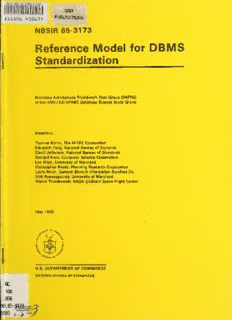
of The Ansi/x3/sparc PDF
Preview of The Ansi/x3/sparc
Reference Model Standardization Database Architecture Framework Task Group (DAFTG) of the ANSI/X3/SPARC Database System Study Group I Members: Thomas Burns, The MITRE Corporation Elizabeth Fong, National Bureau of Standrds David Jefferson, National Bureau of Standards Richard Knox, Computer Science Corporation Leo Mark, University of Maryland Christopher Reedy, Planning Research Corporation Louis Reich, General Electric Information Services Co. Nick Roussopoulos, University of Maryland Walter Truszkowski, NASA Goddard Space Flight Center May 1985 U S. DEPARTMENT OF COMMERCE NATIONAL BUREAU OF STANDARDS 8 » *10.85-3173 [1985 NBSIR 85-3173 REFERENCE MODEL FOR DBMS STANDARDIZATION Database Architecture Framework Task Group (DAFTG) of the ANS1/X3/SPARC Database System Study Group Members: Thomas Burns, The MITRE Corporation Elizabeth Fong, National Bureau of Standrds David Jefferson, National Bureau of Standards Richard Knox, Computer Science Corporation Leo Mark, University of Maryland Christopher Reedy, Planning Research Corporation Louis Reich, General Electric Information Services Co. Nick Roussopoulos, University of Maryland Walter Truszkowski, NASA Goddard Space Flight Center May 1985 U.S. DEPARTMENT OF COMMERCE, Malcolm Baldrige, Secretary NATIONAL BUREAU OF STANDARDS. Enwst Ambler. Dkactor PREFACE This is the final report produced by the Database Ar- chitecture Framework Task Group (DAFTG) of the ANSI/X3/SPARC Database Systems Study Group (DBSSG). DAFTG was formed in November 1983 by David Jefferson and Elizabeth Fong, and met regularly once a month for over a year. A draft working paper entitled "Reference Model for DBMS Stan- dardization" was produced by the members of DAFTG. This working paper was approved by DBSSG, and then presented to SPARC in November 1984. SPARC recommended a release of this working paper to all ANSI committee chairs for review and comment. This version of the "Reference Model for DBMS Standardization" has been edited and revised by David Jefferson and Elizabeth Fong of the National Bureau of Stan- dards . The technical work represents the careful distillation of direct contributions by the members of DAFTG; the opin- ions and ideas expressed here are not necessarily endorsed by the Institute for Computer Sciences and Technology of the National Bureau of Standards. TABLE OF CONTENTS Page 1 INTRODUCTION 2 . 1.1 Objectives for a DBMS Reference Model 2 1.2 Benefits Expected from DBMS Standardization .. 3 1 3 Review of Efforts Toward DBMS Reference Models 4 . 1.4 Requirements for a Reference Model Definition 5 1 5 Intended Audience 5 . 1.6 Scope of the RM 6 1.7 Review of Approaches to RM definition 6 1.8 Structure of the Report 7 2. A REVIEW OF THE ANSI/SPARC DBMS FRAMEWORK 9 2.1 Architecture 9 2.2 Levels of Data Representation 9 2.3 Levels of Data Description 11 2.4 A Model of Data for a DBMS Reference Model ... 13 3. THE DBMS AND ITS ENVIRONMENT 15 3 1 User Roles 17 . 3.2 Application Programs and Application Language Processors 18 3.2.1 Interfaces Between Processors and the DBMS 18 3.2.2 Types and Levels of Commands 20 3.2.3 Conclusions About Interfaces to Applications 20 3.3 The Data Dictionary System 20 3.3.1 Content of the DDS 21 3.3.2 Interfaces to Users 22 3.3.3 Interfaces to the DBMS 23 -iii- 3.3.4 Conclusions about Interfaces for DDS 24 3.4 DBMS Related Tools 25 3.4.1 Application Development Tools 25 3.4.2 Database Design Tools 26 3.4.3 Decision Support Tools 26 3.4.4 Performance Tuning Tools 27 3.4.5 Maintenance Support Utilities 27 3.4.6 Data Entry Software 27 3.4.7 Download/Upload Utilities 27 3.4.8 Support of Multiple Data Models 27 3.4.9 Conclusions about DBMS Related Tools 27 3.5 The Operating and File Management System 28 3.5.1 Processor Control 28 3.5.2 Memory Control 29 3.5.3 I/O Control and Buffer Management 29 3.5.4 Operating System Services 29 3.5.5 Secondary Storage Management 30 3.5.6 Other File Management Services 30 3.5.7 Conclusions about the OS and File Management 31 3.6 Protocols and Distributed Systems 31 3.6.1 Database Functions and the OSI Model 31 3.6.2 Distributed DB Capabilities and OS 34 3.6.3 Conclusions about Interfaces for DDBMS .... 37 4. THE REFERENCE MODEL 38 4.1 Data Analysis 39 4.1.1 The Point-of-View Dimension 42 4.1.2 The Intension-Extension Dimension 43 4.1.3 Data Classification 47 4.2 Function Analysis 49 4.2.1 Basic DMCS Functions - Intension-Extension Dimension 49 4.2.2 Basic DMCS Functions - Point-of-View Dimension 52 4.2.3 Compound DMCS Functions 54 4.3 Data Management Tools 55 4.4 Operating System 56 -iv- 5. CONCLUSIONS 58 5.1 Recommendation for DL Standardization 59 5.2 Recommendation for i-DL Standardization 59 6. REFERENCES 60 7. GLOSSARY 66 -v- I
Description: